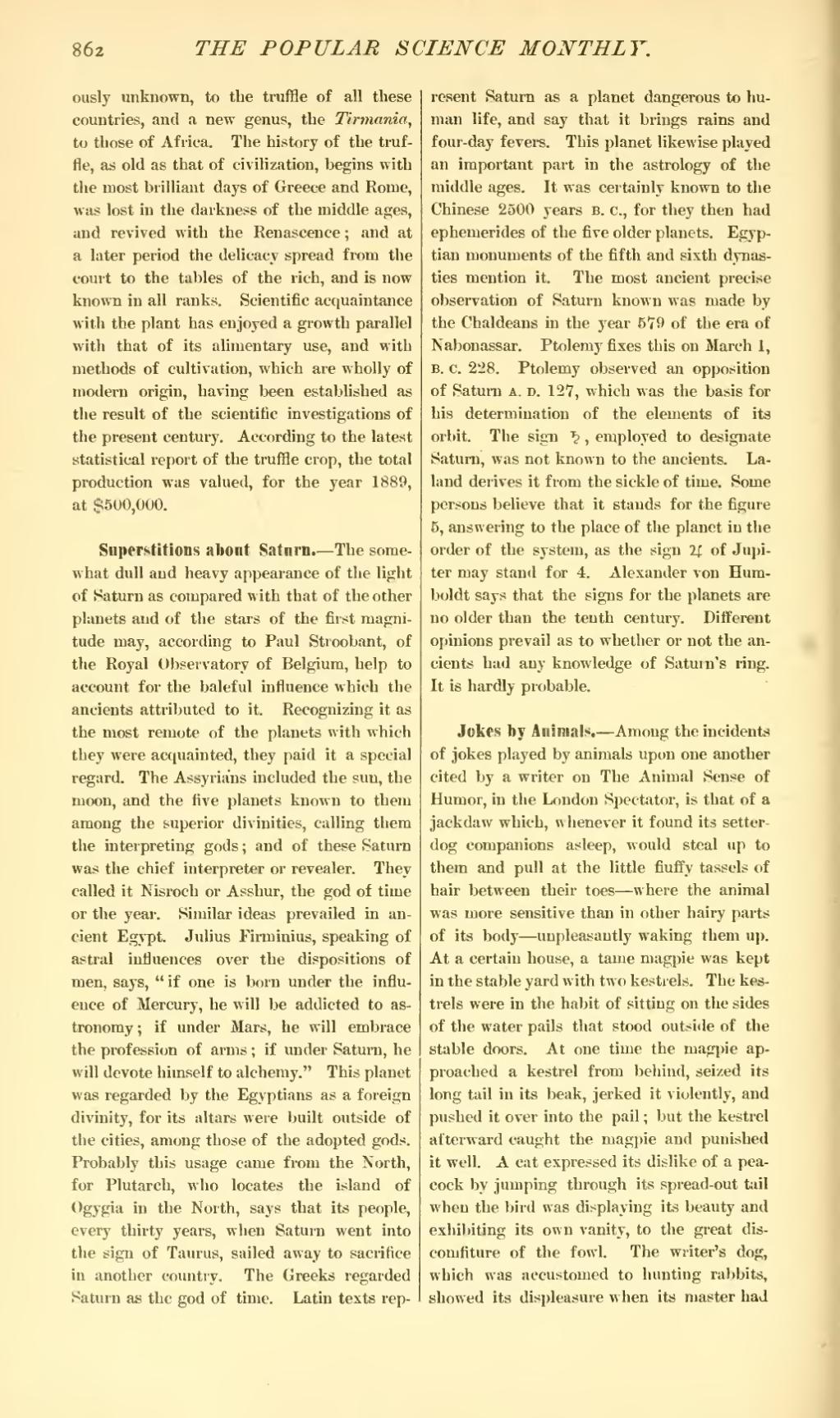ously unknown, to the truffle of all these countries, and a new genus, the Tirmania, to those of Africa. The history of the truffle, as old as that of civilization, begins with the most brilliant days of Greece and Rome, was lost in the darkness of the middle ages, and revived with the Renascence; and at a later period the delicacy spread from the court to the tables of the rich, and is now known in all ranks. Scientific acquaintance with the plant has enjoyed a growth parallel with that of its alimentary use, and with methods of cultivation, which are wholly of modern origin, having been established as the result of the scientific investigations of the present century. According to the latest statistical report of the truffle crop, the total production was valued, for the year 1889, at $500,000.
Superstitions about Saturn.—The somewhat dull and heavy appearance of the light of Saturn as compared with that of the other planets and of the stars of the first magnitude may, according to Paul Stroobant, of the Royal Observatory of Belgium, help to account for the baleful influence which the ancients attributed to it. Recognizing it as the most remote of the planets with which they were acquainted, they paid it a special regard. The Assyrians included the sun, the moon, and the five planets known to them among the superior divinities, calling them the interpreting gods; and of these Saturn was the chief interpreter or revealer. They called it Nisroch or Asshur, the god of time or the year. Similar ideas prevailed in ancient Egypt. Julius Firminius, speaking of astral influences over the dispositions of men, says, "if one is born under the influence of Mercury, he will be addicted to astronomy; if under Mars, he will embrace the profession of arms; if under Saturn, he will devote himself to alchemy." This planet was regarded by the Egyptians as a foreign divinity, for its altars were built outside of the cities, among those of the adopted gods. Probably this usage came from the North, for Plutarch, who locates the island of Ogygia in the North, says that its people, every thirty years, when Saturn went into the sign of Taurus, sailed away to sacrifice in another country. The Greeks regarded Saturn as the god of time. Latin texts represent Saturn as a planet dangerous to human life, and say that it brings rains and four-day fevers. This planet likewise played an important part in the astrology of the middle ages. It was certainly known to the Chinese 2500 years b. c, for they then had ephemerides of the five older planets. Egyptian monuments of the fifth and sixth dynasties mention it. The most ancient precise observation of Saturn known was made by the Chaldeans in the year 579 of the era of Nabonassar. Ptolemy fixes this on March 1, b. c. 228. Ptolemy observed an opposition of Saturn a. d. 127, which was the basis for his determination of the elements of its orbit. The sign ![]() , employed to designate Saturn, was not known to the ancients. Laland derives it from the sickle of time. Some persons believe that it stands for the figure 5, answering to the place of the planet in the order of the system, as the sign
, employed to designate Saturn, was not known to the ancients. Laland derives it from the sickle of time. Some persons believe that it stands for the figure 5, answering to the place of the planet in the order of the system, as the sign ![]() of Jupiter may stand for 4. Alexander von Humboldt says that the signs for the planets are no older than the tenth century. Different opinions prevail as to whether or not the ancients had any knowledge of Saturn's ring. It is hardly probable.
of Jupiter may stand for 4. Alexander von Humboldt says that the signs for the planets are no older than the tenth century. Different opinions prevail as to whether or not the ancients had any knowledge of Saturn's ring. It is hardly probable.
Jokes by Animals.—Among the incidents of jokes played by animals upon one another cited by a writer on The Animal Sense of Humor, in the London Spectator, is that of a jackdaw which, whenever it found its setter dog companions asleep, would steal up to them and pull at the little fluffy tassels of hair between their toes—where the animal was more sensitive than in other hairy parts of its body—unpleasantly waking them up. At a certain house, a tame magpie was kept in the stable yard with two kestrels. The kestrels were in the habit of sitting on the sides of the water pails that stood outside of the stable doors. At one time the magpie approached a kestrel from behind, seized its long tail in its beak, jerked it violently, and pushed it over into the pail; but the kestrel afterward caught the magpie and punished it well. A cat expressed its dislike of a peacock by jumping through its spread-out tail when the bird was displaying its beauty and exhibiting its own vanity, to the great discomfiture of the fowl. The writer's dog, which was accustomed to hunting rabbits, showed its displeasure when its master had
